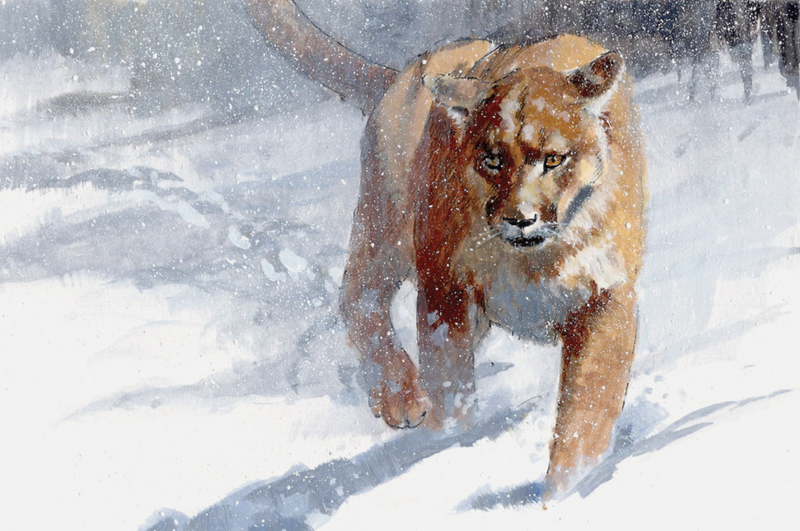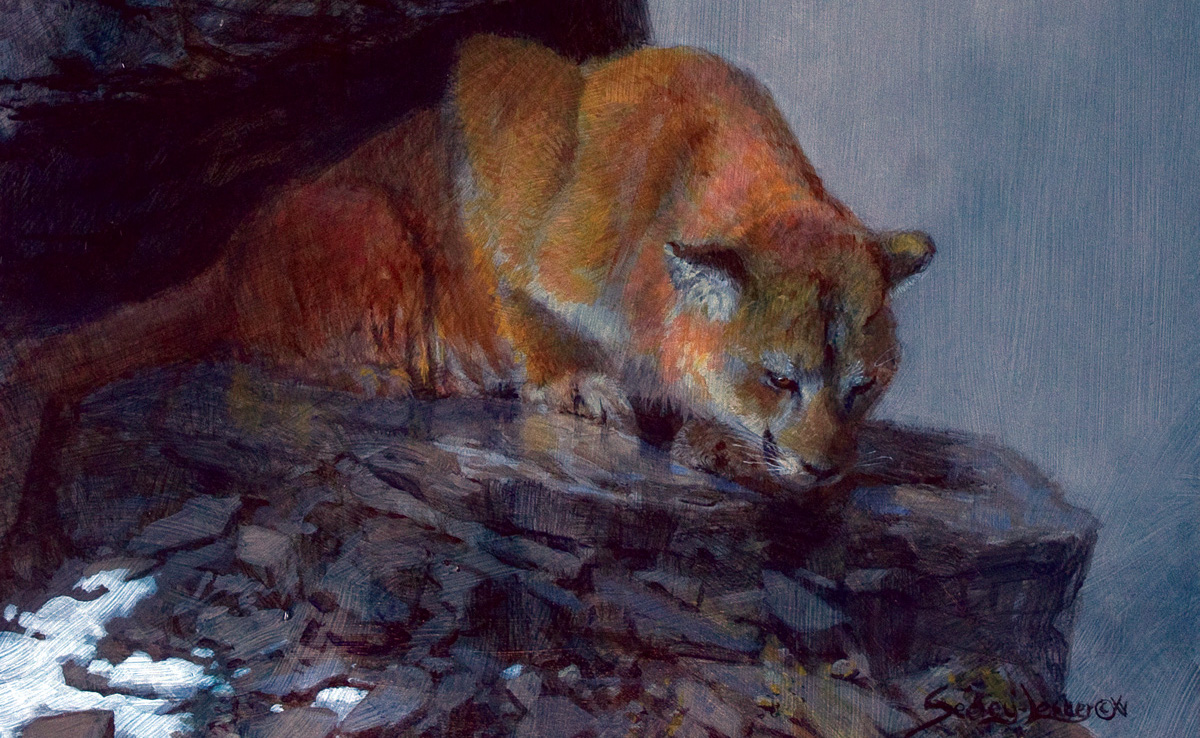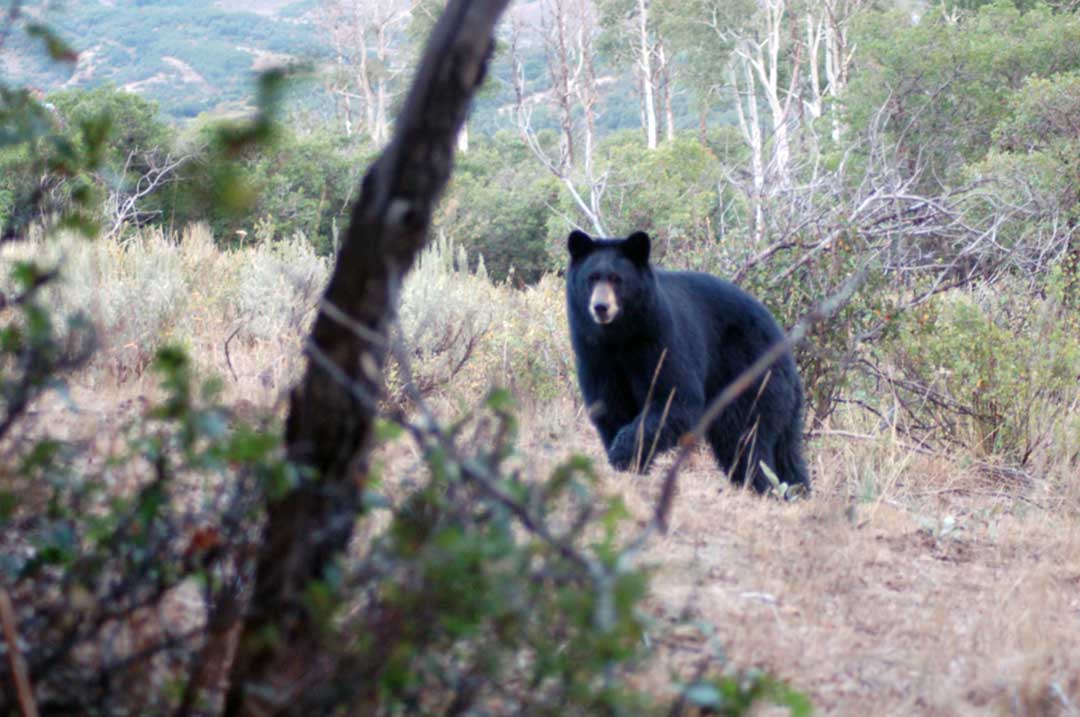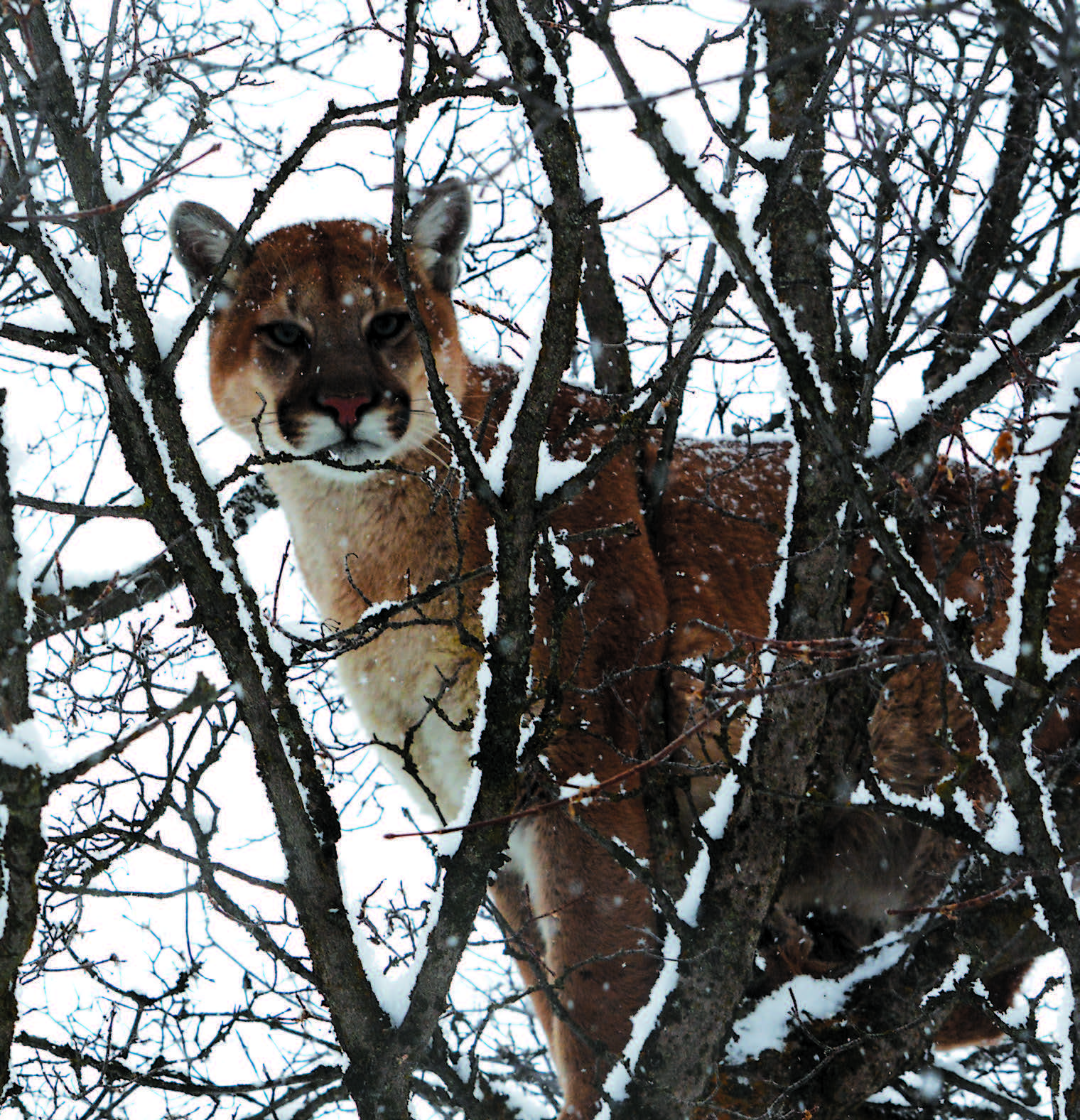“If called by a panther, don’t anther,” said Ogden Nash, and wildlife professionals are heeding his advice…for better or worse.
Randolph County, Missouri. Farm country. November 2012. 2:00 a.m.
A no-nonsense, kick-ass, bread baking, stew simmering, homesteading woman home alone. Hubby was a cop, pulling the night shift when there arose a mighty ruckus in the barn.
“The dog was growling,” she remembers, “…that low, dangerous yet terrified thing. You know it when you hear it and you never want to hear when you’re outside with little more than your nighties, a flashlight and your boots.”
She retreated to the house, locked the door and told her husband about it the next morning. He related the neighbors had lost three cows and had seen what they thought was a panther several days before. The woman strapped on her pistol and seldom left home without it, going on 10 years now.
Several days later, she was walking past an abandoned farmstead close to home, “an empty house, and some tumbledown outbuildings” when she saw the beast, sunning itself on the front porch. She was still a half mile away when it scrambled to its feet and leapt from view. “No coyote or retriever there. That thing had a tail three feet long…I never saw it again, but I’ll carry that cat with me always in my dreams. I somehow think it’s still around.”
Nobody would talk about it, not even the neighbors who lost their stock. Maybe they shot it, buried it quick where the digging was easy, who knows?
And the law? Being a cop’s wife didn’t help. “Everybody knows there are no panthers in Missouri.”
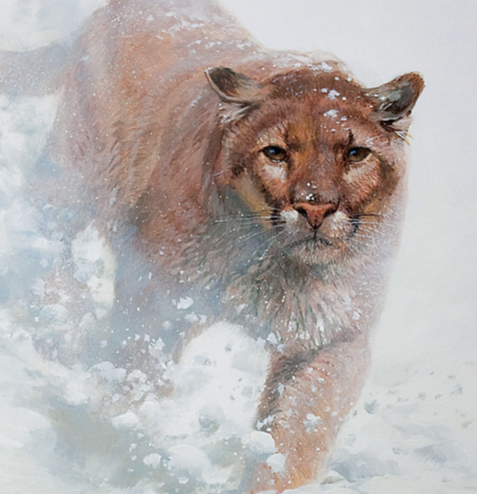
Whiteout (detail) by John Seerey-Lester
“If called by a panther, don’t anther.” That’s Ogden Nash who also said, “God in his wisdom created the fly, but then forgot to tell us why.” And speaking notably of fleeting horizontal relations, “Candy is dandy, but liquor is quicker.”
Nash began composing sappy two liners for greeting card companies and ended up writing wry social commentary for The New Yorker in the 1950s, America’s favorite composer of light verse in those days.
Ogden Nash is long dead, but the panther is still calling.
You call it what you will: Panther, catamount, painter, puma, mountain lion? Officially Puma concolor is the New World’s most widely distributed land mammal, from the Yukon to Patagonia. It calls and it sounds like a woman screaming way down in the woods.
But it’s hard to get wildlife professionals to answer.
Why? “The mandate without the money.”
Hard-strapped for cash, the absolutely last thing a state bureau needs is another endangered species to manage. A population study and a management plan might cost millions. U.S. Fish & Wildlife would be the ones to shuck the shekels so they are mum as well. And then the locals might get all itchy, run them with hounds, tree them, shoot them, like they did the last time. Hard for panthers, people and livestock to coexist. Best keep mum. Or when you can’t keep mum, get right creative in denial.
Though there have been literally hundreds of sightings by otherwise unimpeachable witnesses, the last Eastern panther was officially killed in the mountains of Maine in 1938. Yes, there is an isolated population of several hundred confined to the Everglades, from where individuals occasionally stray, but the other apparitions have been dismissed as bobcats, house cats, barn cats, feral cats, dogs, coyotes, otters and very occasionally escaped or released exotics.
As if on cue, few months after being declared extinct by the U.S. Fish & Wildlife Service in 2011, a panther was struck and killed on a highway outside of Greenwich, CT. At first wildlife officials claimed it an escaped exotic until DNA linked it to a population in the Black Hills of South Dakota, some 1,800 miles away. The officials choked, gagged, then pegged it a Western panther, not an Eastern cat. So, the Eastern panther was still extinct.
Did that panther cross the Missouri and Mississippi rivers by walking across highway bridges, or did it swim both? Did it walk another 2,000 miles to get around?
USFWS refused to speculate.
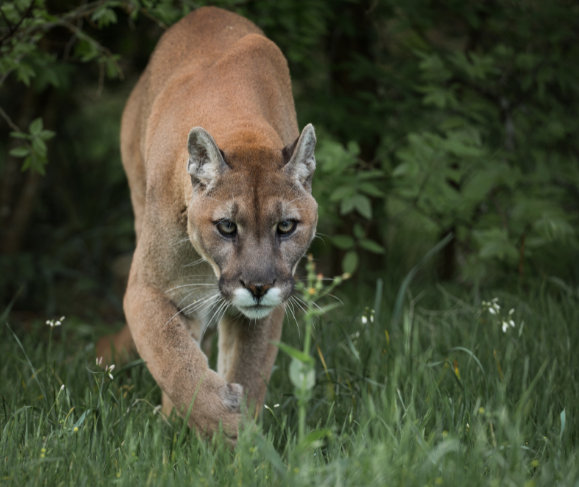
In December of 2014, Kentucky wardens shot and killed a 140-pound male panther in Bourbon County, in a suburb of Lexington. Animal rightists raised Billy-hell as you might expect, but the wardens replied the cat’s proximity to dogs and children gave them no choice. DNA indicated another Black Hills cat but the location of the kill led to further controversy. Why would a notoriously elusive panther haunt a suburb? Fish & Wildlife reasoned the animal had been trapped in the Black Hills and transported to Kentucky by parties unknown and subsequently either escaped or was released. It associated humans with a food source, another reason for its new home in the suburbs and another very good reason for killing it. South Dakota game managers disagreed. Just because the DNA markers indicated the beast came from their general vicinity did not necessarily mean Mount Rushmore. It could have come from anywhere out there, Wyoming, North Dakota, Colorado, even western Nebraska. Years later, the disagreement remains unresolved.
But in November of 2015 Tennessee wildlife officials finally came to Jesus—sort of—when they reviewed game camera photos and videos, 10 in total, not from the mountainous east as you might expect, but from the center of the state south of Nashville. Their admission came with fine print, of course. A panther in the wild, or even 10 panthers in the wild does not constitute a reproducible, sustainable population if there were no females among them. And as the game cameras did not indicate sex, those Tennessee panthers were isolated individuals, like the Connecticut and Kentucky cats, so really, there are no panthers in Tennessee.
Right?
Right!
Almost. If a panther jumps you when you are bent over a deer doing your field dressing chores, does it matter if he or she is reproducible?
Ponder as you will, just watch your ass meanwhile.
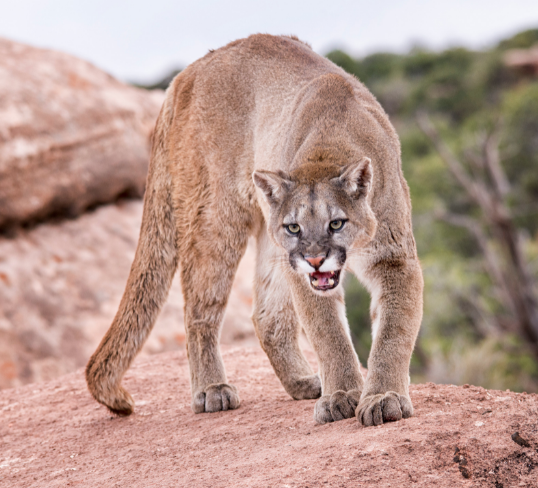
No panic intended and no panic implied. A panther showed up on a game camera in 2016 on a deer lease outside Poughkeepsie, NY. The owner of the cam refused to allow its publication. “We have been trying to get this deer lease for the last five years. If this photo gets out, we will lose it!”
The notion that a panther might be hard on deer hunting was not part of the discussion.
Don’t anther…
A deer lease is chump change but find a panther on the high–ground edge of picturesque southern rice field swamp, on a mountainside with a view along the great Blue Ridge, along a lonesome stretch of pines about anyplace you can name? Kiss your development plans goodbye.
Don’t anther…
Meanwhile, back in Kentucky, Monroe County sheriff, Dale “Frog” Ford got a call from a distressed landowner in September 2018. An unknown animal, or animals, had killed a dog and three miniature horses. Ford, a deputy and two state wildlife officials went out to investigate.
One dog survived the massacre, but he was not talking.
The horses had their throats ripped out, two in a pasture pond, the third inside a barn. The sheriff found a pug mark big as his fist in the mud.
But something did not look right to the Fish & Wildlife men. Grass, weeds and leaves around the presumed kill site were relatively undisturbed. Other than the ghastly wounds, there was little sign of a struggle. Cats are solitary hunters, so why were three horses killed? If one horse was attacked, why did the others not run away? While Sheriff Ford was puzzling over the track, the state men pulled the owner aside for a private conversation, then got into their truck and drove away. “They accused me of shooting my own horses,” the owner said. But what about all those wounds? The state men claimed coyotes, or something, fed on the horses after they were dead.
In February 2019, seven 500-pound llamas were killed and mutilated within the Louisville city limits, followed by two donkeys several days later. Though the same animal, or animals, were suspected in both attacks, the animal, or animals, were never shot, trapped or even identified. A great mystery as both llamas and donkeys will attack and kill trespassing canines, so effectively they are often used as guard animals to protect less aggressive horses, sheep and goats.
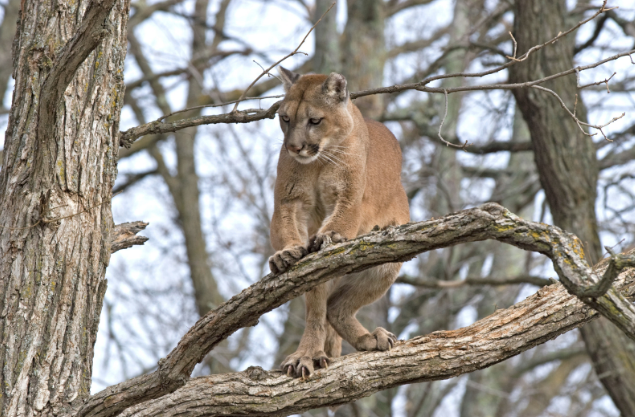
Panthers in Kentucky and Tennessee? Most certainly. But how about North Carolina? A quick internet search turns up dozens of recent sightings, mostly concentrated in the mountainous west or in the thick, blackwater swamps just west of the Outer Banks, sightings complete with witnesses and photos. A woman was killed near Beaufort in 2018 while on a morning run at daybreak. Though canine DNA was identified on the body, the case was never officially resolved, beyond the generic “animal attack.”
But the stories really get twisted down in Georgia, as Georgia stories often do. First half is from the newspaper of record, the Atlanta Journal Constitution, second half from the crossroad and creekside beer joints, Penrose pickled sausages, pickled eggs and pickled talk.
In the 1990s, the Feds imported ten Texas panthers, radio-collared them and released them into the Okefenokee Swamp. Ten years later, they deemed the experiment successful, rounded them up again and released them in the Everglades, where the resident population was suffering from a lack of genetic diversity. Those Texas cats livened things up considerably and it wasn’t long before 60 panthers became 200.
This plentitude of panthers provoked another problem. As the big cats are solitary souls except during breeding season, the range of an adult male might be 100 square miles. As the Everglades are hemmed in by salt water on one side and suburbs on the other three, there simply wasn’t enough room for them all. So, the Feds live trapped another ten, collared them and released them in the big woods north of Apalachicola, way out in the panhandle, wild country, already home to a healthy population of black bear.
But those cats hit the ground running, scattering in all directions. When it became abundantly clear the beasts were not staying where the Feds wanted them, they had to round them back up again. The last was trapped by Lake Hartwell, northwest of Augusta. That cat had travelled nearly 400 miles through reasonably populated country, suburbs of Atlanta, Macon, Athens, without ever being seen. Or if it were seen, nobody bothered to report it! Given 30 years of official denial and ridicule, small wonder nobody called it in.
Meanwhile a deer hunter shot an uncollared panther in Troup County southwest of Atlanta and called the law on himself, provoking a dilemma amongst the experts.
If it were a wild animal, they could levy a $10,000 fine and jail time. But then they would have to admit there were panthers in Georgia.
A post mortem noted scuffing on the pads consistent with walking on concrete. Its intestines contained few parasites so it had not likely been feeding on wild prey. It was officially deemed a released or escaped exotic pet. No fines levied, no jail time, no panthers in Georgia, case closed.
Panthers eat California joggers with distressing regularity, snatch ’em right off the running trails, wipe their lips on yoga pants, one every couple of years on average. But never in the East, not yet anyway.
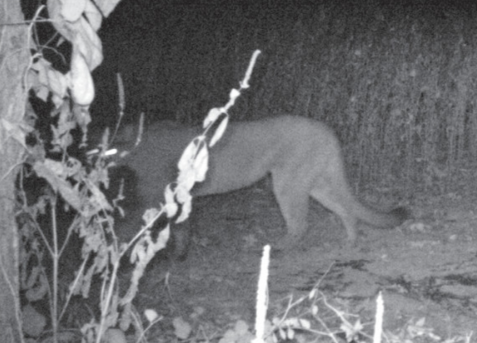
Tennessee cougar caught on trail cam. Image: Tennessee Wildlife Resource Agency
In February 2020, a teenaged boy, Corey Godsey, was attacked in rural Knott County, Kentucky, a remote and rugged area dotted with abandoned strip mines just north of the Tennessee state line. As the attack was fatal, Kentucky State Police took the lead in the investigation, not the Department of Fish and Game. He was staying with his grandpa, who kept a pit bull, so the attack was immediately deemed “canine” as were so many others. But the body was found 400 feet up a steep mountainside stashed in the brush. Canines do not do this but bears and panthers do. In an online interview, a state trooper who assisted recovering the grisly remains said, “there was no indication anyone moved the body to where it was found.” When asked directly about the possibility of a mountain lion, he replied, “We have not ruled out that possibility. But we have no reported sightings of a puma, nor has any showed up on local game cameras.”
But then, there are few functioning game cameras in February.
There is an axion among those of us who study the unpredictable weirdness of the natural world. If you see equine emissions in the middle of a Carolina country road, you think “horse not zebra.” The most logical explanation is generally correct.
But still, a Black Hills cat dead on a Connecticut four–lane is hardly logical, nor is another shot in a Kentucky suburb, ditto a Florida panther travelling undetected from Apalachicola to the shores of a lake on the Georgia-South Carolina border.
Meanwhile, in Glade County, Florida, in March of 2020, a turkey hunter survived a severe swatting. Jason Cook, a professional hunting guide with extensive experience across the U.S. and Canada, was sitting on the ground with his back to a tree trading yelps with an incoming gobbler when a panther hit him from behind, knocking his gun from his hands and sending him sprawling into the grass 10 feet away. “It’s like getting smacked across the back with a baseball bat,” he recalled. Cook was briefly knocked senseless but recovered in time to see the cat’s rear end as it disappeared into the brush. “It was a female,” he said. “Maybe she had kittens and I was in her territory. But I think it was a simple case of mistaken identity. She got me mixed up with the turkey I was calling. But it still hurt like hell.”
Cook stumbled from the woods and encountered a warden on the road. “What in the hell happened to you?”
“I got jumped by a panther.”
The warden gave him the fish-eye. “Now tell me what really happened.”
It took some convincing, but now Cook holds the dubious distinction of being the first panther victim in Florida in recorded history, or at least the first to live to tell the tale.
“I certainly don’t want to see them all shot out,” he said, “but they are big and very dangerous. A good friend had his young daughter on that very tree just a couple of days before. That panther could have easily killed that kid.”
Will he stop hunting turkeys in South Florida? “Oh no. You know the Feds have most of those cats radio-collared. I’d like to develop a cell phone app that would tap into the frequency and show you their whereabouts. That way if there’s a cat close to where you plan to hunt, you can just keep on driving.”
If called by a panther, don’t anther…
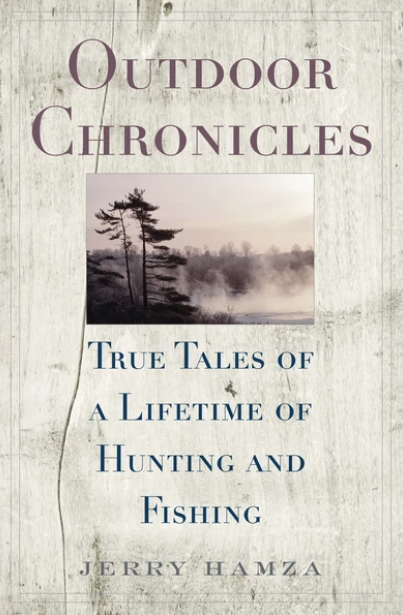 This book is a collection of outdoor stories wrapped in the human condition. They were written with an eye toward honesty and cynicism. They will make you laugh out loud, and you will want to carry them with you wherever you go. If this book goes missing, it’s a sure thing that, when you do find it, it will be in the possession of a member of your household, regardless of their interest in casting a fly. The stories cover the gamut from a fishing trip to northern Canada to a little stream that was actually better than remembered, to how the baby boomers almost trampled a sport to death, to a solitary trek along railroad tracks during a cold, dark, and dreary February and many more. Shop Now
This book is a collection of outdoor stories wrapped in the human condition. They were written with an eye toward honesty and cynicism. They will make you laugh out loud, and you will want to carry them with you wherever you go. If this book goes missing, it’s a sure thing that, when you do find it, it will be in the possession of a member of your household, regardless of their interest in casting a fly. The stories cover the gamut from a fishing trip to northern Canada to a little stream that was actually better than remembered, to how the baby boomers almost trampled a sport to death, to a solitary trek along railroad tracks during a cold, dark, and dreary February and many more. Shop Now

